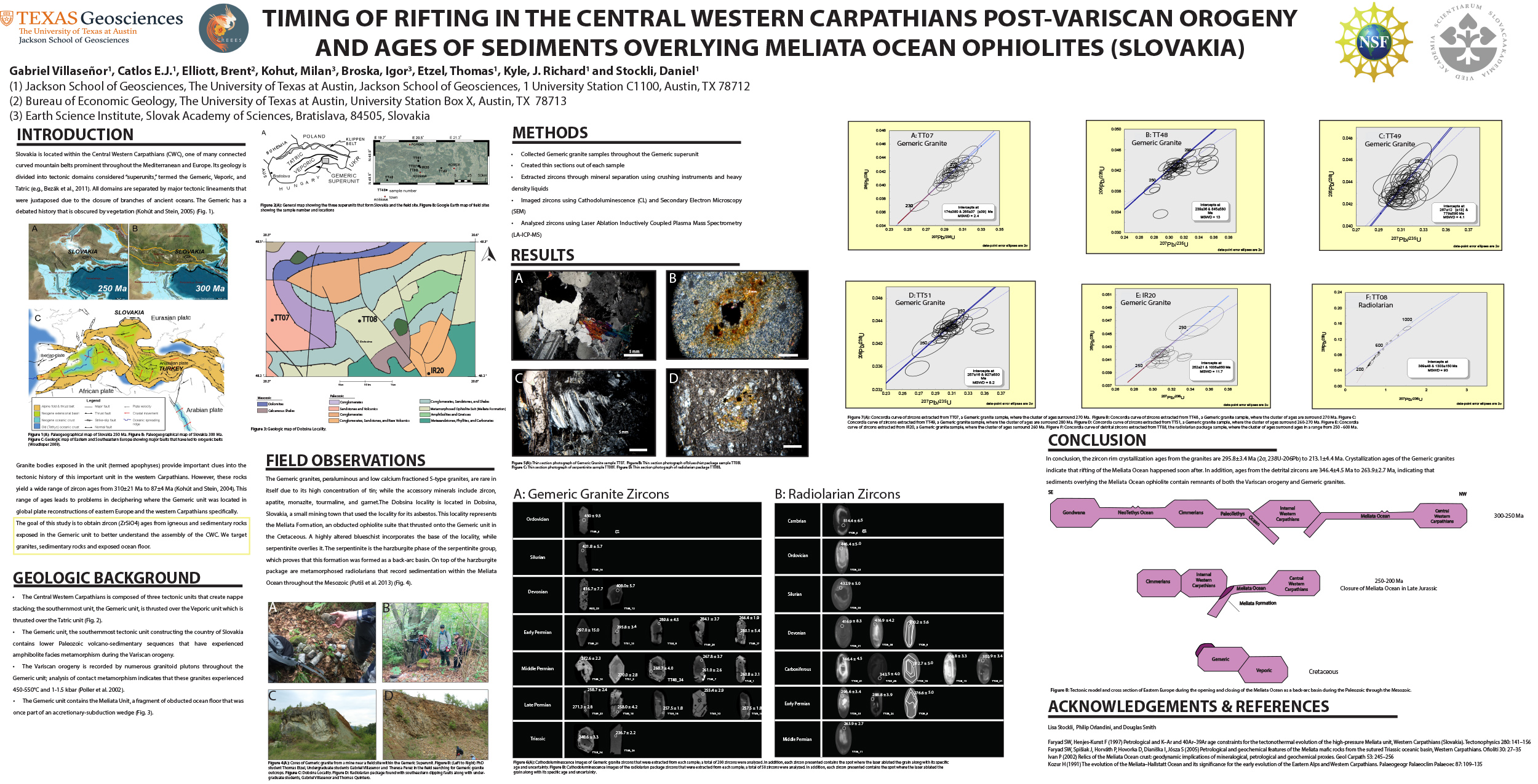Gabriel Villaseñor, Catlos E.J., Elliott, Brent, Kohut, Milan, Broska, Igor, Etzel, Thomas, Kyle, J. Richard and Stockli, Daniel
Slovakia is located within the Central Western Carpathians (CWC), one of many connected curved mountain belts prominent throughout the Mediterranean area and Europe. It is divided into tectonic domains considered “superunits,” termed the Gemeric, Veporic, and Tatric that correlate to the lower, middle, and upper Austoalpine nappes. For example, granite bodies exposed in the unit (termed apophyses) yield a wide range of zircon ages from 310±21 Ma to 87±4 Ma. This range of ages leads to problems in deciphering where the Gemeric unit was located in global plate reconstructions of eastern Europe and the western Carpathians specifically. This case study involves U-Pb dating of magmatic and detrital zircons from the Gemeric tectonic unit. This area records the Variscan orogeny that formed the CWC, rifting, and opening of the Meliata Ocean. This ocean was created due to the formation of a back-arc basin during closing/subduction of the Paleo-Tethys Ocean. We aim to constrain the timing of rifting and identify the provenance of Meliata Ocean radiolarian sediments collected from an obducted Meliata ophiolite suite (Dobsina, Slovakia). The relative age of the Variscan orogeny extends from the late Devonian to early Permian and was followed by rifting throughout the Mesozoic within the CWC. Eventually, the Meliata Ocean closed during the Cretaceous. Zircons from several S-type granites were collected throughout the Gemeric tectonic unit; they were dated using Laser Ablation Inductively Coupled Plasma Mass Spectrometry and imaged using cathodoluminescence. Rim crystallization ages from the granites are 295.8±3.4 Ma (2σ, 238U-206Pb) to 213.1±4.4 Ma. Ages from the detrital zircons are 346.4±4.5 Ma to 263.9±2.7 Ma, indicating that sediments overlying the Meliata Ocean ophiolite contain remnants of both the Variscan orogeny and Gemeric granites.

Comments
Nice work! what sort of rocks did you get the Radiolarian Zircons from? I would naively assume that these are deep water sediments (e.g. chert), but maybe not. If they are deep water sediments, how do you think the zircons got there? The wide range of ages (and variability in zoning) suggests to me they are terrestrially derived from diverse source rocks. I would think that deep water sediments might only have volcanic zircons from an eruptive source (similar ages, perhaps less zones). Where these from turbidites? Also, from a provenance perspective you might consider also plotting U/Th alongside age, and can sometimes help differentiate metamorphic and igneous sources. —Karl Lang
Hello Karl, thanks for the feedback! To answer your questions: The Meliata Ocean formed as a back-arc basin to the Central Western Carpathians (Gemeric superunit), so the grains that record its basement, orogenic period, and post-Variscan partial melting were incorporated into the ocean where it then experienced the formation of the Meliata Formation as an ophiolite suite within the accretionary wedge of the subducting slab as shown in Figure 8. However, the driving force for these sediments are unknown due to a lack of field data; although, I do believe there must have been river systems that may have had runoff into the Meliata Ocean which may have caused the circulation of these grains within the ocean. These radiolarite package zircon grains had a variety of ages that ranged from the Cambrian to the Late Permian. My hypothesis for the Cambrian to Silurian ages come from the Gemeric superunit basement, due to it consisting of Cambrian to Silurian aged volcanic flysch sediments; however, some zircons that were extracted from the Gemeric granites which are Permian in age contain zircons with early Paleozoic ages that are similar to that of the Gemeric basement. For this, I believe that these zircons were plucked from the basement during partial melting and creation of the Gemeric granite plutons. For the zircons that show Devonian to Carboniferous ages, these are possibly from the Central Western Carpathians which were formed by the Alpine Orogeny during these times. The zircons we extracted were from a radiolarite package which you can see in Figure 4D. In addition, the underlying package is harzburgite (from previous studies); however, XRD data that was done at the Jackson of Geosciences, shows this package is lizardite, a serpentinite phase that forms in lower pressures and temperatures. I believe this was formed by either two scenarios: 1.) The serpentinite package experienced a gradual phase transition as the Meliata Formation was thrusted onto the Gemeric superunit. 2.) The locality we looked at formed closer to the trench rather than deeper into the subducting slab. —Gabriel Villaseñor
Thank you for sharing this work. Were you able to personally take part in the field observations in Slovakia? —Rob Reichle
Hello Rob, yes I had the opportunity to be a part of the International Research Experiences for Students (IRES) which was funded by the National Science Foundation (NSF). I was accompanied by my advisor, Dr. Elizabeth Catlos, and mentor, Thomas Etzel, as well as other professors at the Jackson School of Geosciences; who are co-authors to this study. We traveled and observed many of the open and underground mines that Slovakia offers, along with the Tatra Mountains in northern Slovakia. Our field research lasted for a month in the summer of 2018. —Gabriel Villaseñor

